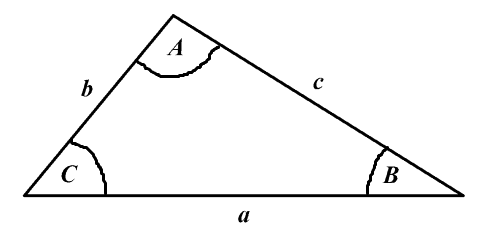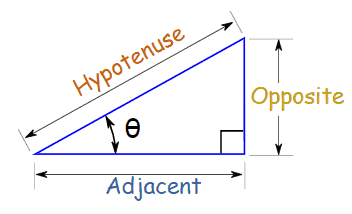By definition, a right triangle is a triangle containing a $90^o$ angle.
Trigonometric functions for any angle are defined by constructing a right triangle about that angle as shown in the figure to the right,
opp and adj are the lengths of the sides opposite and adjacent to the angle $\theta$ and hyp is the length of the hypotenuse.
Basic trigonometric functions
The Pythagorean theorem provides the following relationship among the sides of a right triangle:
Some Trigonometric Identities
From the preceding definitions and the Pythagorean theorem, it follows that:
$\sin^2 \theta + \cos^2 \theta = 1$
The cosecant, secant, and cotangent functions are defined by:
The following are some useful identities among the trigonometric functions:
Some properties of trigonometric functions are the following:
For any triangle
A right triangle has one angle that is 90°. An isosceles triangle has two sides that are equal. An equilateral triangle has three sides that are equal. Each angle of an equilateral triangle is 60°.

-
The sum of the angles of any triangle is 180°: $ \;\;\;\;\; A+B+C = 180^o $
-
Two triangles are similar if two of their angles are equal. The corresponding sides of similar triangles are proportional to each other: $ \;\;\;\;\; \dfrac{a_1}{a_2} = \dfrac{b_1}{b_2} = \dfrac{c_1}{c_2}$
-
The law of cosines and the law of sines apply to any triangle, not just a right triangle, and they relate the angles and the lengths of the sides:
$\dfrac{\sin A}{a} = \dfrac{\sin B}{b} = \dfrac{\sin C}{c} \;\;\;\;\;\;\;\;\;\;\;\;\;\; \text{law of sines} \\ $
$c^2 = a^2 + b^2 -2 ab \cos C \;\;\;\;\;\;\;\;\;\;\;\;\;\; \text{law of cosines}$
Exercises
With help from the preceding trigonometry rules, try to solve the following exambles:
- In a certain right triangle, the two sides that are perpendicular to each other are 5.00 m and 7.00 m long. What is the length of the third side? Answer
- In a certain right triangle, the two sides that are perpendicular to each other are 3.00 m and 4.00 m long. What are the angels of the triangle? Answer
- A right triangle has a hypotenuse of length 3.0 m, and one of its angles is $30^o$. (a) What is the length of the side opposite the $30^o$ angle? (b) What is the side adjacent to the $30^o$ angle? Answer

You don`t have permission to comment here!
Report